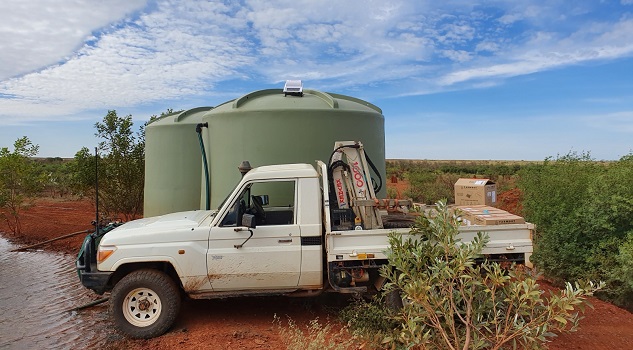Farmbot Monitoring Solutions brings technology to the land to improve both sustainability and productivity.
Farmbot Monitoring Solutions is an Australian agritech company that harnesses the Internet of Things (IoT) in precision agriculture. The company monitors and reports on-farm water ecosystems delivering near real-time reporting on water trends, consumption and demand. As the lifeblood of all agricultural endeavours, a detailed understanding of water usage helps farmers make better management decisions around asset utilisation, resource allocations and stock-carrying capacities.
Farmbot was established in Sydney in 2013. Its founder and COO, Craig Hendricks, was a city-based software developer with a small farm in the Southern Highlands of New South Wales, who was keen to keep an eye on his cattle, water and fences while he was at his day job in Sydney. He developed a range of primitive remote-monitoring devices to check his water levels, electric fences, temperature, soil moisture and turn his pumps on and off remotely.
Since those humble beginnings Craig’s monitors, now called Farmbot Monitoring Solutions (Farmbot), have turned into a national company that has over 3300 monitors running on properties all over the country, including on some of the leading livestock operations in Australia like AACo, CPC and Kidman Pastoral.
“Many technology companies fail because they attempt to solve a problem that doesn’t exist.”
Andrew Coppin, the company’s managing director, with family ties to farming and rural Australia, has always been a passionate advocate for the better use of technology in agribusiness to improve productivity, sustainability and profitability. After an extensive executive career in capital markets and funds management, he has spent the last five years in the agritech sector mentoring emerging technology companies as an investor, adviser and company director. As well as his role at Farmbot, Andrew is also a founding director of the Australian AgriTech Association, an industry body that seeks to further Australian agritech companies and support their growth.
Harnessing the power if the IoT
Today Farmbot uses state-of-the-art IoT monitors alongside advanced software, algorithms and satellites to monitor on-farm assets and resources such as water levels, rainfall, temperature, water quality, electric fences, pumps and other metrics that provide greater security and peace of mind to farmers around the country.
“At any given time, there are probably about 10,000 farmers driving around their properties checking on their water,” Andrew explains. “That’s 10,000 vehicles driving and producing carbon emissions and 10,000 other jobs around the farm not being done.”
By providing a real-time look at a farmer’s water ecosystem, they know that if anything has gone wrong with their water (e,g a broken pump or leaking tank) they will be alerted almost instantly and they can triage and rectify any issues. And instead of driving around in the morning looking at water, they can check on their water via their smartphone while having breakfast with their family.
Until now, while all other inputs in agriculture are monitored to the litre, kilo or metre, water has been less revered as it comes from the sky, a river or under the ground.
“Producers, governments and growers the world over are developing a new appreciation for the sensitivities and volatility of the world’s most precious resource, and the opportunity to help them manage it with precision is prescient,” Andrew says, adding that the Farmbot of the future is key to farming operations the world over as the base for sending and receiving communications and data on farms.
“It will allow for accurate assessments of trends in water, pasture, livestock welfare and weight gain,” he enthuses.
Technology not just for the technology’s sake
While Farmbot’s IoT technology has been an important driver of the business, Andrew believes it’s the team’s attitude to technology that has led to their success and growth to date.
“Many technology companies fail because they attempt to solve a problem that doesn’t exist, or they push technology developed overseas into an Australian market and climate where it is not fit for purpose,” Andrew says.
“All our research and development is undertaken at our Sydney research facilities or on Australian farms with real-life farmers and problems.”
During the course of COVID-19, with the economy shrinking and most businesses consolidating operations, Farmbot hired five engineers to help develop new solutions for current and future customers. And they describe themselves as a farmer-led company, developing technology off the back of conversations with Australian producers.
“We listen to our customers to find out what solutions they want, what solutions they need and then we get to work on making it happen,” Andrew explains. “In fact, one of our biggest innovations, our partnership with Inmarsat which allows two-way communication, came about after speaking with Australian farmers and them telling us ‘Wouldn’t it be great if we could also perform actions remotely as well as monitor’.”
A focus on sustainability
Historically, adoption of technology on farms has been hamstrung by connectivity issues, but Andrew is excited about the opportunities that exist with satellite solutions and the new era of communications ahead of us.
“Inmarsat’s real-time, duplex (two-way) communications, for example, will bring amazing functionality to rural Australia such as affordable satellite-controlled pumps and remote machinery control,” he says. “This partnership has the potential to significantly improve the management of critical water resources and on-farm infrastructure for farmers worldwide, resulting in tangible productivity gains. The development of on-demand operation of pumps, cameras and machinery for farmers has significant and far-reaching benefits spanning individual farm profitability, carbon reduction and ultimately more sustainable outcomes.”
From a sustainability perspective, Farmbot’s technology negates the need for farmers to spend their days driving to check water sources. For large farms this could mean a reduction in thousands of kilometres of driving per week, in turn creating a positive impact with a reduction in carbon emissions, wear and tear on vehicles, infrastructure and material reduction in occupational health and safety risks.
“In agriculture, and for that matter many other industries, sustainability and productivity are seen at opposite ends of a spectrum,” Andrew bemoans. “But this technology is a clear example of how sustainability and productivity can be improved together.”
The global market for agritech innovation products and services is around $US500 billion and this is growing at 8 per cent a year, which Andrew sees as a huge opportunity for Australian businesses as the country is one of the powerhouses of agriculture.
“Our vision is to create an end-to-end water management platform with the launch of the trough monitoring system that works alongside our existing water level, rainfall, pressure and flow sensors,” Andrew says. “The partnership with Inmarsat helps us deliver these solutions via satellite so there are no connectivity problems in helping pastoralists and graziers remove their water management blind spots.”
Having recently won Food & AgriTech Scale-up of the Year at the Australian Technologies Competition, which identifies Australian technology scale-ups with global potential, Farmbot are setting their sights higher and heading overseas.
“We are aiming to have around 50 monitors being trialled in California by the end of this year as we finalise plans to officially launch in the US as well as in South America,” Andrew says. “We’re excited to bring this technology to the world.”
This story first appeared in issue 31 of the Inside Small Business quarterly magazine
















